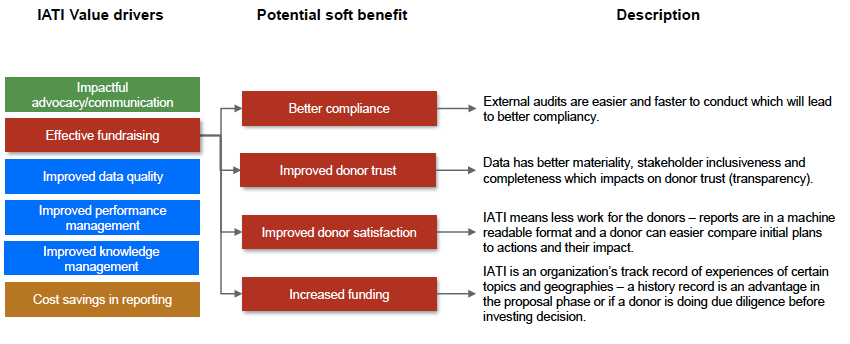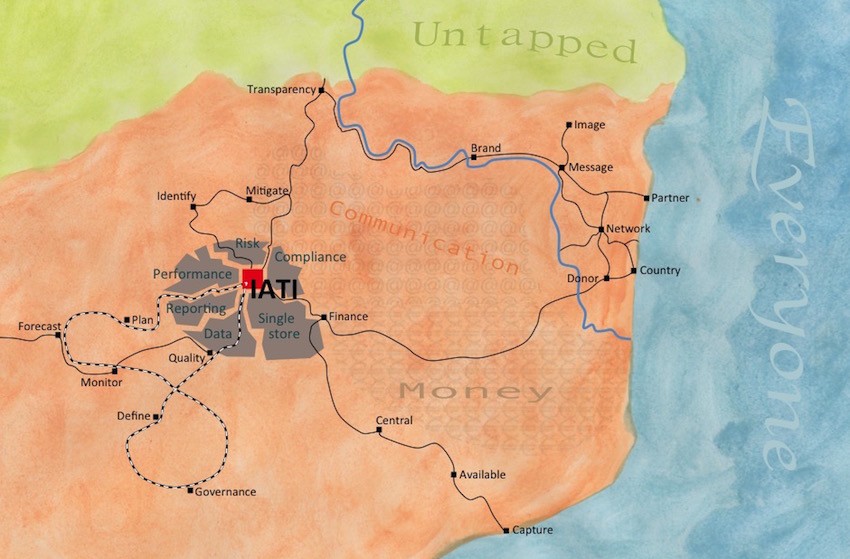Akvo’s partner Plan International Finland has been collaborating with Accenture Finland and various other parties to answer exactly these questions, and share the findings with the development sector at large – while also implementing Akvo RSR to publish its own projects to the IATI registry. Together, Plan Finland and Accenture have created an open framework that allows organisations to do a cost-benefit analysis for IATI publication, and decide for themselves what to do.
The toolset of this framework consists of two documents:
- IATI business case framework (PDF) aimed at explaining the framework
- IATI business case framework template (Excel) with the business framework structure including an example.
“Development funds are precious and we, as development organisations, have a moral responsibility to organise our work as well as we can and overcome any waste. IATI is a tool to improve coordination. This framework is created to help provide understanding of the benefits IATI can have for your organisation, to assess them over time and to help advocate to others.” – Mika Välitalo, from Plan Finland.
Why is a business case framework needed?
The Dutch and UK governments now require IATI reporting from all international development programmes that they fund, and this has caused many organisations to begin sharing their data via the IATI registry. But many still view it merely as a tick-box reporting exercise.
In fact, with the right level of investment, IATI offers many benefits, such a smart way for organisations to walk the transparency talk, make their work more visible and coordinate projects more efficiently. This creates a clear feedback loop, leading to the publisher seeing IATI’s usefulness and therefore being willing to invest further in improved quality data sharing. John Adams called this ’the virtuous circle’ during the IATI Technical Advisory Group meeting in Ottawa in 2015.
But it’s difficult for organisations to know where to start, especially as getting on board requires an investment of effort and resources. A clear understanding of the benefits they can expect to reap from embracing the IATI data structure could help a lot here.
Goal
The primary goal of this business case framework is to provide information about the benefits, costs and risks involved in publishing your information in the IATI standard. It aims to form the basis for effective decision making on where and how to invest in IATI-based reporting.
The framework provides clear and concise fact-based information that supports decision making. It is used for:
- understanding the qualitative and quantitative value and cost of the estimated IATI investment,
- helping in decision-making between different options to improve reporting,
- gaining alignment between everyone involved,
- obtaining management commitment and approval for investment in an IATI project,
- tracking success during and after the IATI investment.
In short; it helps you work out what you can do to achieve the highest benefit with the minimum investment, based on your organisation’s needs.
Get prepared
Understanding IATI is key. What is its purpose, how does it work theoretically and how does the sector use it in practice? Having a basic level of knowledge on IATI is a requirement to be able to move forward. Resources to get you started on this can be found on Aid Transparency and on the videos page. When you’ve done some research on what it’s about, you can dive into the cost-benefit analysis. Below I’ve summarised some key components of the framework.
How ambitious are you?
Using the ambition model is step one. It will help you gain a good understanding of where you are now and what you would like to aim for in the short and long term. The key is to focus on identifying “how to get most from IATI with the least investment”.
Factors to consider are, for example: why, what, who, where and how IATI is used for publishing in an organisation; how often is data refreshed, and how complete does the data need to be? The ambition levels are organised by six ‘reporting enablers’: governance, data, technology, collaboration, talent and incentives. The ambition levels and what these may look like for the latter two elements (talent and incentives) are shown here below.

Above: Example of ambition levels of an organisation when looking at two of the six reporting enablers: talent and incentives. See page 21 and onwards of the IATI business case framework.
Business case
In the spreadsheet format, Accenture set up a framework which includes various quantifiable cost elements using a calculation model ie. using a data entry form to enter your specific situation and ambition. Included are for example cost savings on data management and reporting and one-off and recurring costs of adopting IATI, such as IT system costs.
Some of the savings are broad assumptions and need to be treated with caution. Furthermore, suggested enhancements to the business case are very welcome; you can find our contact details below.
How to deal with non-quantifiable benefits
If all benefits of IATI could be monetised, creation of the complete image would be a piece of cake. As it is not that simple, the framework contains a second module; the decision matrix.
The decision matrix is aimed at gaining clarity on how the soft benefits support an organisation’s strategic and financial objectives. For example; implementing the IATI data structure as a common data definition in the organisation can help to align existing data management processes and responsibilities between communications, marketing, finance, and programme management departments.
The decision matrix is not aimed at valuing the ‘soft benefits’, but rather aimed at helping you to get a handle on them and decide which to take most seriously. These potential benefits, or ‘IATI value drivers’ are categorised as follows:
- Impactful advocacy/communication
- Effective fundraising (see example below)
- Improved data quality
- Improved performance management
- Improved knowledge management
- Cost savings in reporting (fully measurable)

Above: Example of potential soft benefits for more effective fundraising. Page 35 of the IATI business case framework.
How it all comes together
When going through the steps – of course involving colleagues from across your organisation – it is possible to define several scenarios and estimate the investment payback time. Also, key performance indicators (KPIs) can be defined to measure progress towards your goals. But more importantly, going through the framework will help you to judge the value of the soft benefits to your organisation.

Above: Example graph of the cost-benefit analysis of the quantifiable parts of the framework. Page 47 of the IATI business case framework.
What’s next?
If you want to know more, feel free to get in touch. We expect that this framework could be further enhanced. Feel free to get involved.
This work is published under Creative Commons License (CC BY-NC-SA 4.0). Contacts: marten@akvo.org, mika.valitalo@plan-international.org and tomi.nummi@accenture.com


